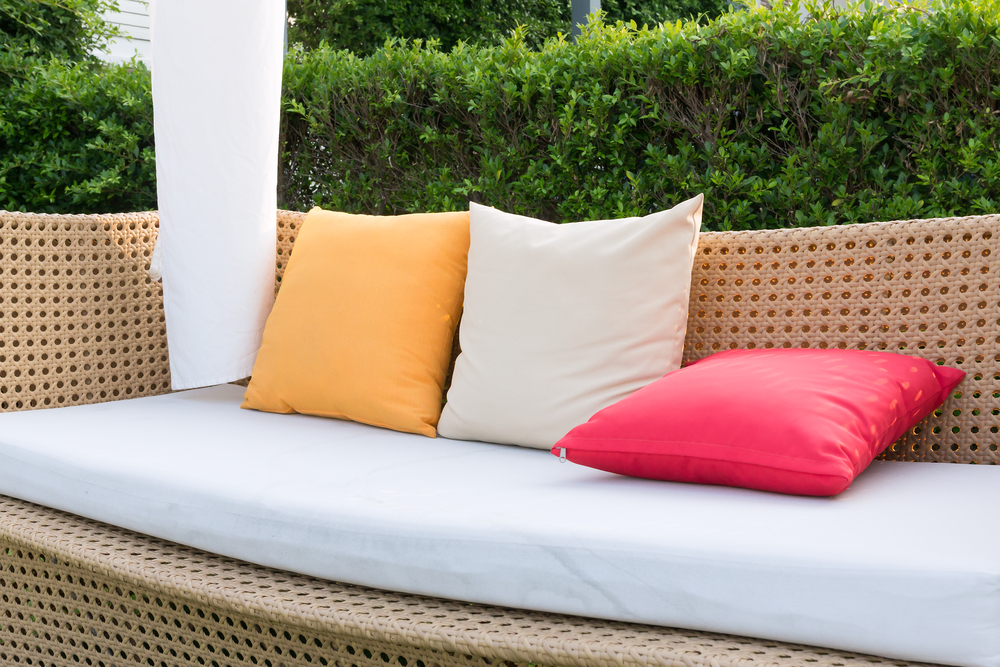Patio furniture cushions endure a lot of heavy use and potential damage from the elements, especially when left out in rough conditions. They can also get soiled from food and beverage spills, bird droppings, mildew, and even mold. But don’t despair: We’ll let you in on some tricks on how to clean outdoor cushions and keep them from getting dirty in the first place so you can save time later.

Use a trusty washing machine
Good for: Heavily soiled, machine-washable cushions, covers
Granted, the obvious answer to thoroughly clean patio furniture cushions is tossing them into the washing machine, then letting them air dry, or using a low temperature setting on your dryer. However, some cushions aren’t designed for washing machines, as this may damage the fabric or stuffing, leaving you with frayed fabrics or flat seats. Instead, follow the steps below.
Step 1: Check the tags.
Before using a washing machine, check your cushion’s wash care tags to make sure they’re actually machine washable. Note that removable zippers or button cushions are usually machine washable.
Step 2: Only use bleach if necessary.
Skip out on the bleach if your cushion doesn’t have mold or mildew, as this extra detergent can actually irritate skin, especially if you have little ones who like to hang out on the patio. Regular detergent and warm water should suffice.
Step 3: Air dry.
If you’re concerned about shrinking, let the cushions air dry in the sun.

Handwash cushions with a solution
Good for: Delicate fabrics, spot stains
If your fabric needs gentle care, consider handwashing to get stains out. Silk covers, cushions with appliques, rayon, leather, and fur are standard no-nos when it comes to washing machines and should be treated with appropriate solutions.
Step 1: Use a wet cloth and detergent.
When in doubt, use a wet cloth with mild detergent to lift fresh stains and prevent discoloration. Even if your stains are caked in, handwashing cushions might be better than using a washing machine.
Step 2: Consider a fabric brush.
You can use a fabric brush to scrub out stains on hardier cushions using strong stain removers.
Step 3: For leather covers: Use a leather conditioner and refresher.
Step 4: For fabric cushions: There are also spot sprays you can use to treat surface stains for fabric-based cushions.
Furthermore, there are efficient stain fighters at home which you simply need to dig out of that kitchen or storage.

Soak the cushion before washing
Good for: Mildew or mold
You might have thought about replacing your patio furniture cushions especially after noticing the mold buildup — but wait, there are solutions. Your patio furniture cushions might become riddled with mildew or mold if left in wet or humid conditions. Beverage spills left untreated might also lead to mildew on and within the cushion.
You can use a spray bottle to soak the cushions or create a large amount of mixture in a bucket to submerge your cushions. Leave the cushions for 15 minutes to an hour and then wash off the mixture and dirt with your garden hose. Instead of borax, you can add some bleach to thoroughly eliminate mold.
Another common dirt might be tree sap on your cushions. SFGate suggests applying detergent to the affected area and waiting 30 minutes before wiping it off. Another suggestion is using an enzyme-based stain remover to break down the sap. Keep the solution on for at least 15 minutes. Alternatively, you can use an extra-strength detergent and a handheld brush to scrub away the sap. Wash off any leftover solution and sap with water.

Keep them from getting dirty
An easy way to keep your patio furniture like new is to do all you can to prevent dirt buildup and stains.
Use covers or upholstery protectors
For heavily used patios, consider vinyl or plastic cushion covers. You can also treat your fabric with upholstery protectors to avoid stains. Moreover, they’re usually safe for all fabrics, even silk. There are also many options that don’t contain harmful chemicals, making them safe for household use. One example is Vectra, which is available in large hardware stores.
Store cushions indoors during the off-season
Another way to keep your cushions clean is taking them inside during seasons when they’re not in use. This might mean storing them in your garage during rainy seasons or snowy months. This will help prevent mold, sun damage, and general breakdown.

Spot clean your cushions
If you have one spot that's bothering you, you can try to treat just that area without soaking the entire cushion.
Step 1: Remove the cushion and move it to an area that you can treat it. Perhaps bring it inside on a covered area of your kitchen counter or on the floor on a spread-out garbage bag.
Step 2: Use a borax mixture, OxyClean, or another spot treatment that is used on fabric.
Step 3: Thoroughly read the directions before beginning the spot treatment to ensure the fabric is approved for the type of cleaner. Let it sit and wash according to the directions.
Even if you know how to wash patio cushions, it’s still a good idea to take some preventive measures. This way, you save time scrubbing down cushions and surface stains in the future. And, even if your cushions seem beyond cleaning, try one of our cleaning tips to bring them back to life.




